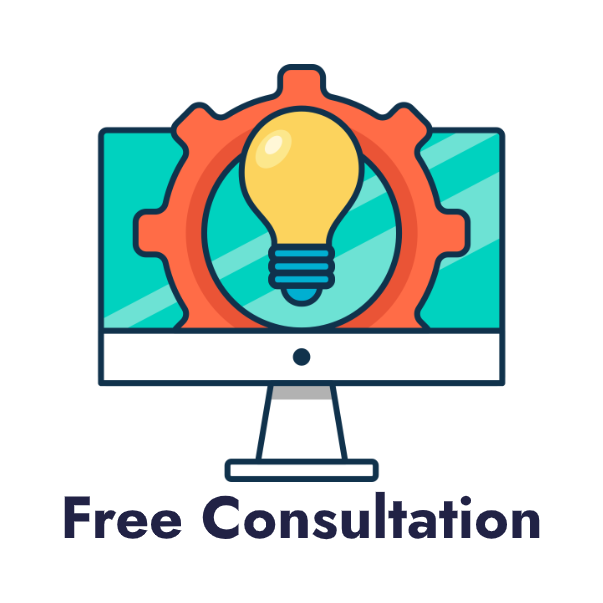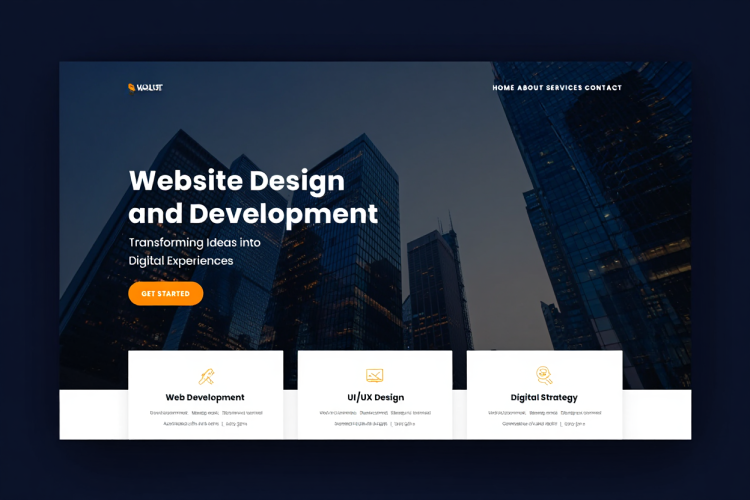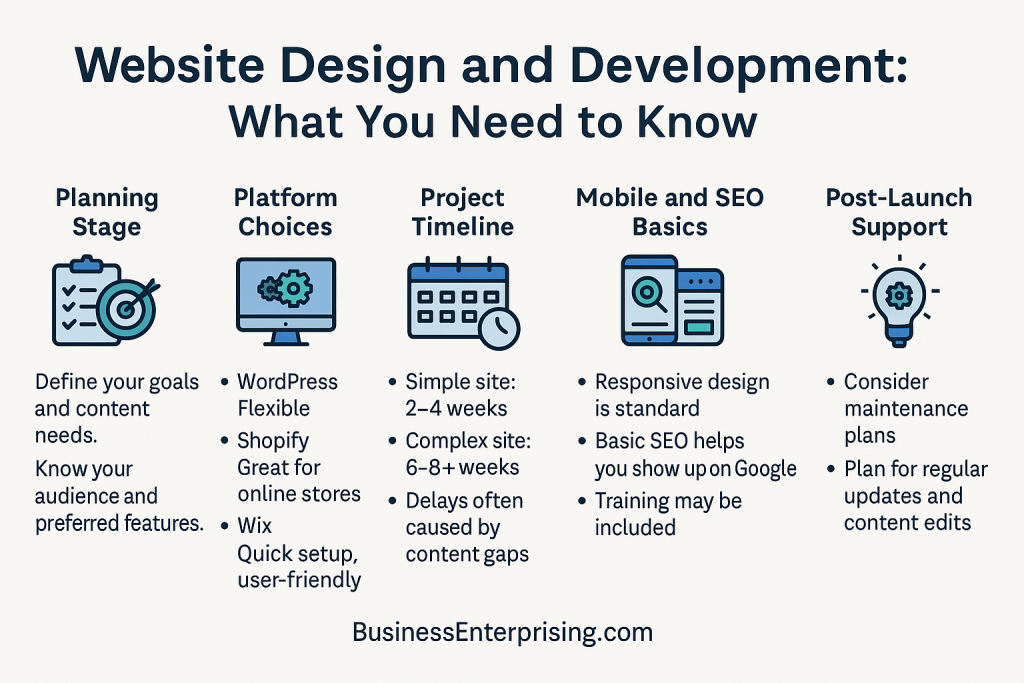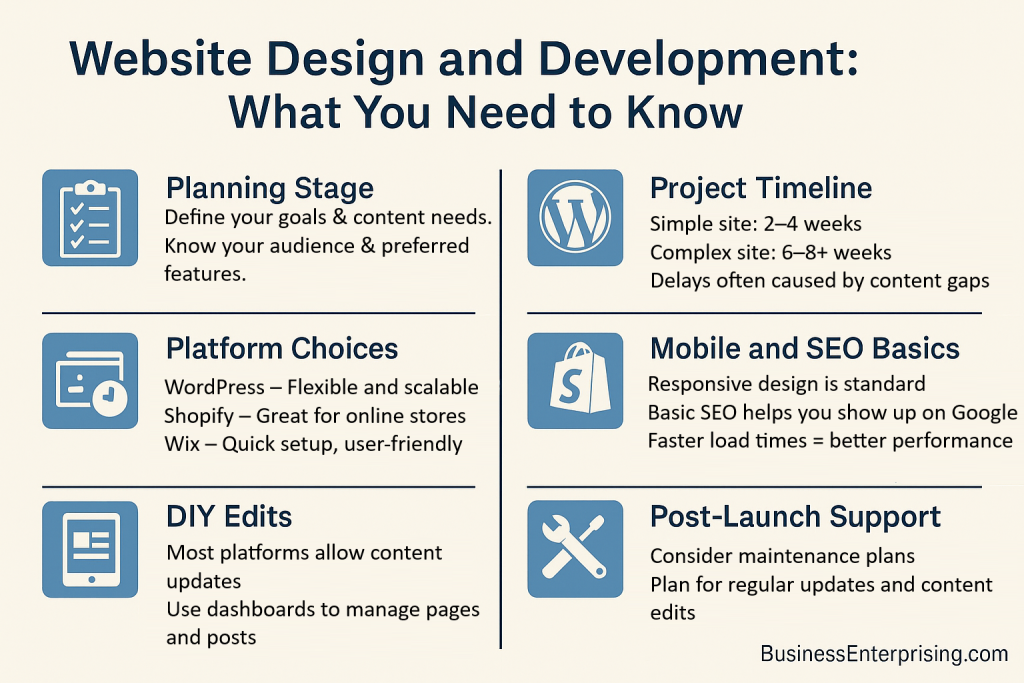
Additionally, you may be curious about editing your own content or showing up on search engines. These questions come up often during early planning. Therefore, getting familiar with the process helps you make better choices. A little preparation upfront can save time later.
Your goals, timeline, and budget will shape the outcome. However, most designers can work with a wide range of needs. Additionally, today’s tools offer more control and flexibility than ever. You don’t need technical skills to launch something professional.
Each platform has different strengths. Some are better for selling products. Others focus on ease of use. Therefore, the right one depends on what you want your site to do. Additionally, your content and features will influence that decision.
A well-planned website can support your business and grow with it. However, a rushed or unclear approach may cause delays. Therefore, having clear goals can make the process smoother and less stressful. You don’t have to figure it all out alone.
Working with a designer gives you structure and support. Additionally, it helps you avoid common mistakes early on. With the right planning, your website can be ready to support your next step.
How much does website design cost?
Website design costs vary widely, typically ranging from a few hundred to several thousand dollars depending on complexity and features.
Website design pricing can be confusing at first. You may find offers starting at a few hundred dollars and others reaching into the thousands. The final cost depends on how simple or complex the site will be. A basic brochure site is often less expensive than one with e-commerce, booking systems, or custom features.
However, pricing isn’t only about the number of pages. Design quality, functionality, and content preparation all affect the total investment. Additionally, your timeline and how prepared you are with content can raise or lower the cost. If your site needs revisions or last-minute changes, that could also affect pricing.
Some designers charge a flat rate. Others may bill by the hour or in phases. Therefore, it’s smart to ask for a written quote before you agree to move forward. Also, compare a few proposals to see what each includes. You may notice that some offer content writing or SEO, while others do not.
Website design and development services can also include extras like mobile optimization and analytics setup. These are often standard, but not always. So it helps to clarify what is included in the scope of work. Additionally, find out if training or post-launch support is offered.
You should budget for updates after launch as well. Websites need occasional edits, software updates, or small improvements over time. Therefore, it’s helpful to ask if the designer offers maintenance plans. Clear expectations can prevent issues later.
Overall, pricing is flexible and depends on your goals. However, a well-designed site is an investment that reflects your brand and builds trust.
How long does it take to design a website?
Most websites take between 2 to 8 weeks to design, depending on the size, scope, and client responsiveness.
The time it takes to complete a website depends on many factors. Most projects take between two and eight weeks to finish. Simple websites move faster, while complex ones take longer. However, delays often happen when content or feedback is slow.
Additionally, your level of preparation affects the timeline. If you already have text and images ready, that speeds things up. On the other hand, needing help with content or branding may add time. Therefore, staying responsive during the project helps keep things on schedule.
The process usually includes planning, design, revisions, and final testing. However, each step depends on good communication between you and your designer. Revisions often take the most time, especially if goals change midway. Therefore, be clear about your needs from the start.
Website design and development often includes more than just building pages. It can also cover mobile responsiveness, search setup, and content adjustments. Additionally, the more features you want, the longer it may take to complete the project.
If you’re on a deadline, mention that up front. Designers can often adjust their schedule for quicker turnarounds. However, rush projects may cost more or skip some stages. Therefore, plan ahead if you have a fixed launch date in mind.
Ultimately, no two projects take the same amount of time. However, with good planning and clear direction, you can launch your site smoothly. Being organized makes a big difference and helps avoid unnecessary delays.
Will my website be mobile-friendly?
Yes, modern websites are designed to be fully responsive and function seamlessly on all devices, including smartphones and tablets.
Mobile-friendliness is now a standard part of website design. Your site should look good and work well on phones and tablets. Most modern platforms automatically support responsive layouts that adjust to fit different screen sizes.
However, not all designs function equally well across devices. Therefore, it’s important to test your site on multiple screens. Additionally, buttons, menus, and forms should be easy to tap on smaller displays. These small details can make a big difference in user experience.
Mobile users expect fast load times and easy navigation. Therefore, your designer may recommend compressing images and simplifying layouts. These changes often help reduce bounce rates and improve engagement. Additionally, fewer pop-ups and clean formatting tend to work best on mobile.
Website design and development now centers around mobile usability. It’s no longer an optional feature or extra service. Instead, it’s built into how most sites are created. Therefore, your developer will usually include mobile optimization as part of the project scope.
If you already have a site, you may want to check how it performs on mobile. However, if you’re starting fresh, responsive design will likely be part of the plan. Additionally, most content systems now support mobile features by default.
Ultimately, a mobile-friendly site benefits your business and your visitors. It helps more people access your content quickly and easily. That makes your website more effective no matter how your audience finds you.
Can I update the website myself after it’s built?
Yes, most websites are built with user-friendly content management systems (like WordPress) that allow easy updates.
Most modern websites are built using platforms that make updates simple. You can usually change text, images, and even layout elements yourself. WordPress, for example, offers a dashboard that’s easy to learn and use.
Additionally, many website design and development projects include basic training after launch. This helps you feel confident managing your content. Therefore, you don’t need to rely on a developer for every small change. However, some technical updates may still require support.
You can add blog posts, update services, or replace photos without much effort. Additionally, some builders offer drag-and-drop features to make editing even easier. These tools help you keep your site current with minimal hassle.
If you plan to update your site often, let your designer know early. That way, they can structure the layout with that in mind. Additionally, they may suggest tools or plugins that make content editing faster. Therefore, your input at the start affects your ease later on.
However, not all edits are risk-free. It’s easy to accidentally break formatting or delete key content. Therefore, it’s helpful to back up your site before making large changes. Additionally, having access to support can save time when something goes wrong.
Overall, the goal of most website design and development work is to give you control. You should be able to manage your site without stress. A little training and planning go a long way toward making that possible.
What platform should my website be built on?
The best platform depends on your needs, but WordPress, Shopify, and Wix are popular choices for flexibility and ease of use.
Choosing the right platform depends on what your website needs to do. Some platforms offer more flexibility, while others simplify the process. WordPress is a common option for blogs and business sites. However, Shopify is ideal if you plan to sell products online.
Additionally, Wix is popular for small businesses that want quick results without learning complex tools. Each platform has its own strengths and limitations. Therefore, it’s best to match the platform to your goals. Think about what features you need now and in the future.
If you want full control over design and plugins, WordPress is a strong choice. However, it does require more maintenance and occasional updates. Additionally, it offers thousands of templates and extensions, which can be helpful as your site grows.
Shopify simplifies selling online with built-in tools. It handles inventory, checkout, and payments with ease. Therefore, it works well for retail businesses. Wix offers drag-and-drop tools for fast setup. However, it can be harder to scale or customize over time.
During the website design and development process, your designer can recommend the best platform for your project. Additionally, they can explain how each one will affect cost, features, and control. Therefore, be clear about your goals from the start.
The platform you choose affects how easy it is to update, grow, and manage your site. With the right fit, your website will work for you—not against you.
Will my website show up on Google?
Yes, basic SEO practices are applied during design to help your website get indexed and rank on search engines like Google.
Most websites are built to show up on Google. Basic SEO steps during setup help your pages get indexed by search engines. However, appearing high in search results takes more than just being online. You need helpful content, relevant keywords, and clean structure.
Additionally, your website design and development should support fast loading times and mobile responsiveness. These factors improve user experience and also help with ranking. Therefore, your developer may include technical SEO tasks like meta tags and image optimization.
If you’re launching a new site, it may take a little time to appear in results. However, you can speed this up by submitting your site to search engines. Additionally, connecting tools like Google Analytics and Search Console can help track progress.
Your content plays a big role in visibility. Therefore, make sure your pages answer common questions your audience may ask. Also, updating your content regularly keeps your site fresh and more likely to be indexed.
Some platforms have built-in SEO tools that guide you through the basics. However, your designer may also recommend ongoing SEO services for better results. Additionally, creating blog posts or landing pages helps expand your reach over time.
Ultimately, being visible on Google depends on how well your site is built and maintained. A strong foundation makes a difference. With the right structure and strategy, your site can become easier to find by the people who need it.
Conclusion
Website design and development involves more than just making your site look good. It shapes how people interact with your business online. A thoughtful design can improve user experience and help you reach your goals faster.
However, the process works best when you understand what to expect. Therefore, take time to ask questions and plan ahead. Additionally, be clear about your needs and goals before starting a project. This saves time and avoids costly changes later.
You don’t need to be a tech expert to manage a successful website. However, working with someone who understands the tools can help. Additionally, staying involved during the process helps keep things moving forward. Your feedback plays a big part in shaping the final result.
The best websites support your business and grow with it. Therefore, think beyond the launch date and plan for future updates. Additionally, consider how your audience will use your site over time. Regular updates can keep content fresh and relevant.
You may want to learn how to make small changes yourself. However, it’s also fine to get help when needed. Many developers offer support or training options. Additionally, maintenance plans can keep your site running smoothly.
In the end, a well-built website works as an extension of your business. With the right website design and development, you can build trust and stay competitive. The time and effort you invest can bring long-term value.



